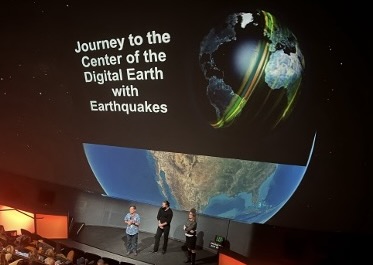
 |
| February 2024 Volume 13 Issue 1 |

Robust and efficient visualization tools are essential for Earth scientists to effectively uncover patterns and trends in data and models to interpret Earth's interior and processes. Meanwhile, emerging visualization techniques also play a crucial role in public outreach to create engaging and effective ways to share scientific results with the public and inspire students to STEM fields by transforming abstract data into visually compelling 3D experiences.
Virtual Reality and planetarium theaters provide unprecedented opportunities for the scientific community to interact with their audiences. As part of the NSF-funded SPAC-MAN (Slabs, Plumes, And Convection in MANtle) project, we facilitate 3D visualization for exploring data and models to advance education and public outreach promoting deep-Earth geophysical studies. To demonstrate the use of immersive environments in different branches and scales, we build an interactive user experience using the global adjoint tomographic mantle models as the basis, which are constructed based on 3D numerical modeling of synthetic seismograms and data ... [full article]
Dear Community,
One of the initial goals of the first CIG proposal was to develop infrastructure for model interoperability. Early efforts included an example of nesting of a local convection model inside a coarse-resolution global model. Realizing the initial vision of model interoperability has remained a long-term goal. With the changed computational landscape, CIG returns to this question - how should we enable the development of Earth-systems models capable of linking computational models with distinct functionality?
Our starting point is to solicit input from the community about science priorities and infrastructure needs. We plan to explore these questions in a webinar series The path to model interoperability in geodynamics. Speakers will address a broad range of science problems in which model integration is an essential component. Please join us in attending the webinar series and participate in the discussions.
Bruce Buffett & Lorraine Hwang, Co-Directors
Do you know someone who would be a great ambassador for CIG research? The CIG Speaker Series is looking for talented speakers who can promote computational modeling in geodynamics and related earth sciences to a broad scientific audience. Open a ticket and include on the first line, "SPEAKER NOMINATION". More information for speakers and institutions looking for speakers can be found on our website. Deadline is February 28, 2024. [info]
Please join us in welcoming Alice Gabriel to the Executive Committee and Sylvain Barbot and Qinya Liu to the Science Steering Committee. Thanks to our Nominating Committee - Joyce Sim Shi, Ebru Bozdag and Cathy Constable and to everyone who participated by running and voting in this year's elections.
CIG Monthly Webinars have a new time Thursdays @noon / 12P PT. The 2024 webinar series will focus on current efforts to understand the relationship between different systems in geosciences. By presenting examples of coupled geodynamics models and the difficulties encountered in coupling them, speakers of this series invite us into exploration and discussions of the science opportunities and challenges in code coupling and multidisciplinary research. See the webinar page and the calendar for more information.
| February 8 | Coupling Geodynamic and Landscape Evolution Models Robert Moucha, Syracuse University [register] |
| February 22 | Venus through time: building coupled evolution models for rocky planets. Cedric Gilman, ETH Zurich |
| March 14 | Matthew Hoffman, LANL |
| April 11 | Frank Zwaan, GFZ Potsdam |
| April 25 | I. Thomas Frasson, Université Grenoble Alpes; II. Daniel Thallner, University of Florida |
| May 9 | Thomas Theunissen, University of Bergen |
| May 16 | Bernhard Schuberth, Ludwig-Maximilians-Universität München |
| April 30 | SPECFEM Developers Workshop | Anchorage, Alaska | |
| May 28-June 7 | ASPECT Hackathon | Fort Collins, Colorado | |
| June 10-14 | Crustal Deformation Modeling Workshop | Golden, Colorado | |
| June | Rayleigh Hackathon | tbd |